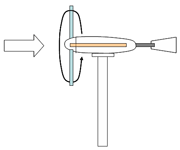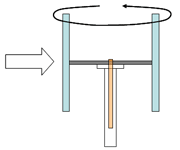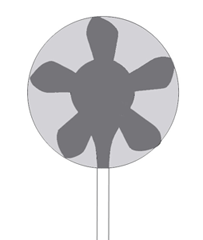
Type of Windmill
According to the direction of the rotation axis of the windmill, there are two main types: the horizontal-axis type (mainly the propeller) and the vertical-axis type.
In terms of the type of torque generated by winmill, they can be classified into those that use the drag force generated on the blades of the windmill and those that use the lift force.
Windmills are mainly used for wind power generation of the lift force.
 |
 |
| Horizonta-Axis Windmill | Vertical-Axis Windmill |
Windmill Power Generation Efficiency
Supposing letting V:[m/s] be the wind speed (per second), A: [m2] be the swept area of the blade, ρ:[kg/m3] be the air density, and Cp be the power coefficient of the windmill, the power generated by the windmill P:[W] is obtained by the formula of P=Cp×(1/2)×ρ×A×V3.
According to Betts law, the maximum power coefficient Cp that can be extracted from the wind is 16/27 (Betts coefficient).
It shows that up to 0.593 of the power of the wind can be extracted theoretically.
It can be said that the higher the Cp, the higher the power output performance of the windmill.
From the above formula, it can be seen that the power of the windmill is proportional to the swept area and to the cube of the wind speed.
Windmill power P is also expressed as torque [N-m] x rotational angular velocity [rad/s].
This represents the power converted from the power of the windmill to electricity by the generator.
By increasing the force applied to the shaft of the windmill and increasing the rotation speed, the power output that can be extracted from the windmill increases.
In a general large propeller windmill, we try to increase the power generation efficiency by reducing the blade area that can be a drag force and increasing the rotational speed (peripheral speed).
Bellsion-type windmill is devised to increase the power generation efficiency by expanding the blade area that draws out the lift force and increasing the rotation speed to the optimum level.
Bernoulli's Theorem
The law of conservation of energy dictates the relationship between the pressure and the flow velocity.
To generate the lift force by using this relationship is the idea of aerodynamics.
Current windmill blades are being researched based on aerodynamic wing theory.
 |
Coanda Effect
This is a phenomenon in which a fluid flows along the surface of an object as if it sticks to it.
It was discovered by Henri Coanda, who is credited with inventing the jet engine.
By using this phenomenon, it is possible to generate a pressure difference around the object and to accelerate the flow of the fluid or change the flow direction.
 |
Windmill Performance Evaluation
Generally, when evaluating the performance of windnills, the performance is evaluated by using characteristic coefficients such as the power coefficient, the tip speed ratio, and the solidity.
The power coefficient indicates the ratio of the power that can be extracted from the windmill based on the wind power obtained from the wind receiving area of the windmill.
In the actual windmill, it is about 0.4 for the lift-type high-performance propeller-type large-scale windmill, and about 0.15 for the drag-type Savonius windmill.
The tip speed ratio is the ratio between the tip speed of the windmill blade and the wind speed.
In the lift-type windmill, the blade tip can rotate faster than the wind speed, and in the drag-type windmill, it can only rotate below the wind speed.
The solidity is defined as the ratio of the total projected area of the windmill blade to the swept area of the windmill. (Fig. 1)
A. According to Betts, there is the fixed law for the solidity and the tip speed ratio when extracting the maximum power from any windmill.
It is assumed that it falls within the range of the curve and the curve (shadow part). (Fig.2)
 |
 |
| Fig.1 Propeller-Type Windmill Solidity | Fig.2 Relationship between Windmill Solidity And Tip Speed Ratio |

Global Energy Co., Ltd.
1964-1, Kamijima, Hamakita-ku, Hamamatsu-shi, Shizuoka-ken, 434-0011, Japan